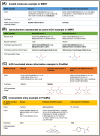Insights into predicting small molecule retention times in liquid chromatography using deep learning
- PMID: 39375739
- PMCID: PMC11460055
- DOI: 10.1186/s13321-024-00905-1
Insights into predicting small molecule retention times in liquid chromatography using deep learning
Abstract
In untargeted metabolomics, structures of small molecules are annotated using liquid chromatography-mass spectrometry by leveraging information from the molecular retention time (RT) in the chromatogram and m/z (formerly called ''mass-to-charge ratio'') in the mass spectrum. However, correct identification of metabolites is challenging due to the vast array of small molecules. Therefore, various in silico tools for mass spectrometry peak alignment and compound prediction have been developed; however, the list of candidate compounds remains extensive. Accurate RT prediction is important to exclude false candidates and facilitate metabolite annotation. Recent advancements in artificial intelligence (AI) have led to significant breakthroughs in the use of deep learning models in various fields. Release of a large RT dataset has mitigated the bottlenecks limiting the application of deep learning models, thereby improving their application in RT prediction tasks. This review lists the databases that can be used to expand training datasets and concerns the issue about molecular representation inconsistencies in datasets. It also discusses the application of AI technology for RT prediction, particularly in the 5 years following the release of the METLIN small molecule RT dataset. This review provides a comprehensive overview of the AI applications used for RT prediction, highlighting the progress and remaining challenges. SCIENTIFIC CONTRIBUTION: This article focuses on the advancements in small molecule retention time prediction in computational metabolomics over the past five years, with a particular emphasis on the application of AI technologies in this field. It reviews the publicly available datasets for small molecule retention time, the molecular representation methods, the AI algorithms applied in recent studies. Furthermore, it discusses the effectiveness of these models in assisting with the annotation of small molecule structures and the challenges that must be addressed to achieve practical applications.
Keywords: Deep learning; Liquid chromatography; MassBank; PredRet; QSRR; RepoRT; Retention time prediction; SMRT; Small molecules; Untargeted metabolomics.
© 2024. The Author(s).
Conflict of interest statement
The authors declare no competing interests.
Figures




References
-
- Jordan MI, Mitchell TM (2015) Machine learning: trends, perspectives, and prospects. Science 349(6245):255–260 - PubMed
-
- Dührkop K, Fleischauer M, Ludwig M, Aksenov AA, Melnik AV, Meusel M, Dorrestein PC, Rousu J, Böcker S (2019) SIRIUS 4: a rapid tool for turning tandem mass spectra into metabolite structure information. Nat Methods 16(4):299–302 - PubMed
Publication types
Grants and funding
LinkOut - more resources
Full Text Sources
Miscellaneous

